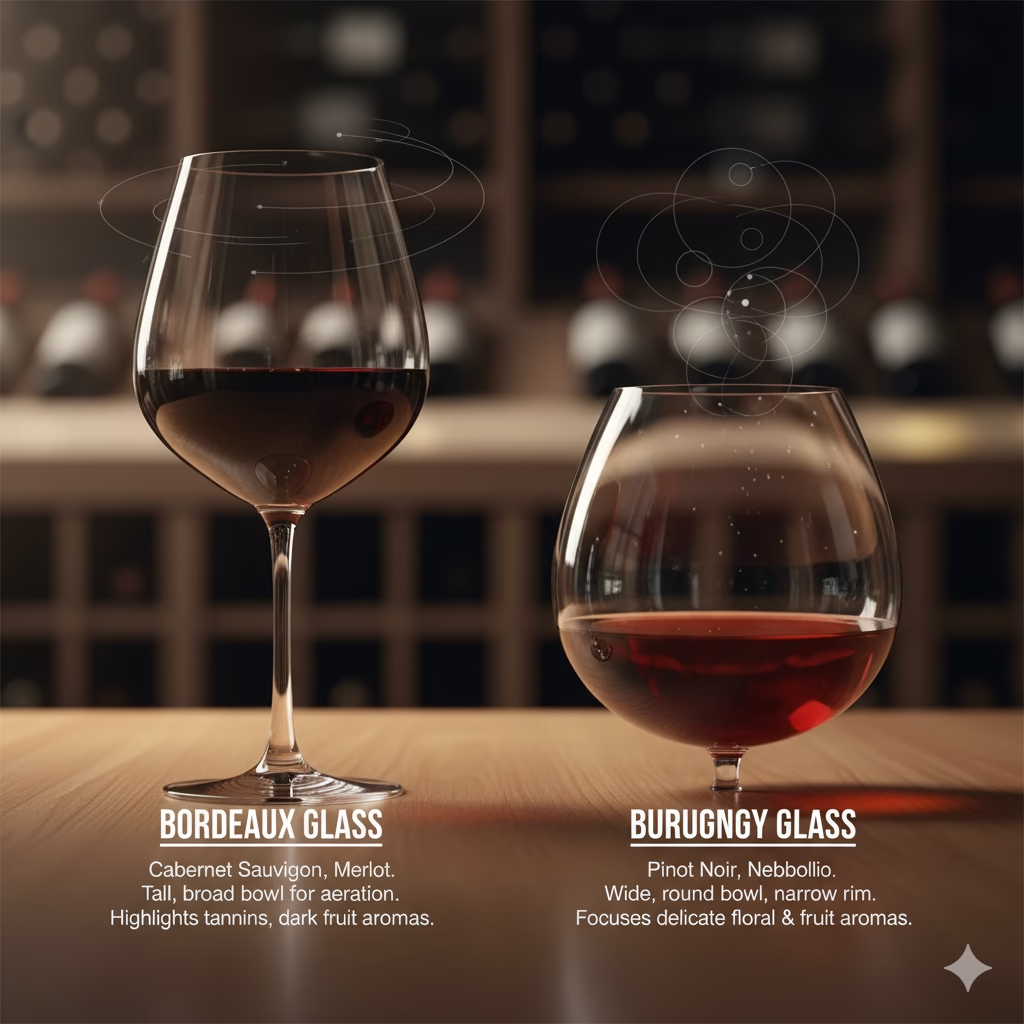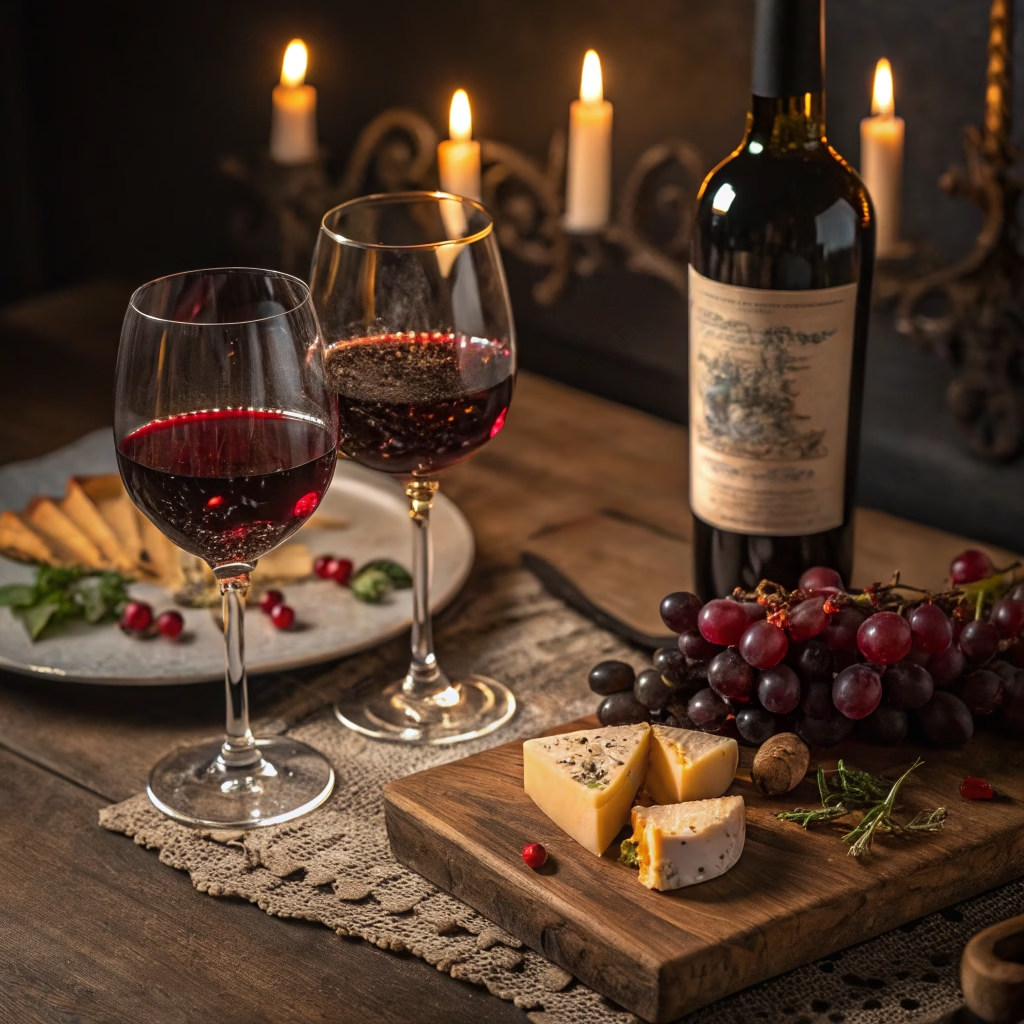Table of Contents
Understanding the Importance of Red Wine Glasses
The design of red wine glasses significantly influences the tasting experience, engaging multiple senses to enhance enjoyment. The wide bowl of red wine glasses allows for better aeration, which is essential for releasing the wine’s rich aromas. This exposure of wine to air helps soften tannins and enhance flavor profiles, contributing to a more pleasurable tasting experience. Results from various studies indicate that the shape impacts how aromas are directed towards the nose, directly influencing perception of taste. A glass that narrows at the rim, for instance, concentrates aromas, making them more pronounced on the palate. [Source: Wine Enthusiast]
Furthermore, the size of the glass also plays a role; larger glasses not only enhance oxygenation but allow for swirling, which increases the wine’s exposure to air and facilitates a more dynamic sensory evaluation. The visual enjoyment of the wine’s color and clarity is similarly affected by the glass’s transparency and shape, adding to the overall sensory pleasure. Therefore, using the appropriate glassware is pivotal, as it can transform a simple tasting into a rich and immersive experience. Using a glass specifically designed for red wines ensures that one derives the maximum depth of aroma and flavor, thereby elevating the wine tasting experience.
Types of Red Wine Glasses and Their Uses

Red wine glasses vary significantly in shape and size, each tailored to enhance the specific characteristics of different red wine varietals. Understanding these types can elevate your wine-tasting experience.
Bordeaux Glasses
These glasses are tall and wide with a broad bowl, designed for full-bodied wines like Cabernet Sauvignon and Merlot. The shape allows ample oxygenation, enhancing the wine’s rich aromas and flavors. Specifically, Bordeaux glasses focus on highlighting structured, tannic wines, which benefit from the wider surface area at the rim that directs aromas to your nose. The larger bowl promotes the release of complex fragrances such as dark fruits and spices, which is essential for appreciating the depth of these robust wines. [Source: Tasting Table]
Burgundy Glasses
In contrast, Burgundy glasses are shorter and rounder, ideal for lighter, aromatic reds like Pinot Noir. The wide bowl allows for the wine to breathe, softening tannins and maximizing delicate aromas. The narrow rim focuses the aromas towards the nose, making it ideal for wines that showcase floral and fruit notes. This glass enhances the tasting experience by concentrating the subtle scents that are characteristic of Burgundian varietals, leading to a more nuanced appreciation of the wine’s profile. [Source: Wine Enthusiast]
Other Red Wine Glasses
Additional options include stemless glasses, which offer a casual aesthetic, and glasses designed specifically for other varietals like Syrah or Zinfandel. Stemless glasses provide a more contemporary feel, but may not preserve temperature quite as effectively, impacting tasting quality. It’s crucial to choose the right glass to enhance the unique traits of each wine type, improving both aroma and flavor experiences during tasting sessions. [Source: The Spirited Glass]
Best Red Wine Glasses for Different Wine Types
Selecting the right glass for specific types of red wine enhances the tasting experience. Here’s a breakdown of the best glasses for popular red wine varieties:
Cabernet Sauvignon
For Cabernet Sauvignon, choose a glass with a tall bowl to allow the wine to aerate, facilitating the release of its rich aromas and flavors. The wide rim encourages you to enjoy the bold structure and complex tannins characteristic of this variety. Recommended glasses include the Riedel Vinum Cabernet Sauvignon and the Schott Zwiesel Tritan Crystal Cabernet Glass, both designed to enhance the depth of flavors. [Source: Wine Enthusiast]
Merlot
Merlot benefits from a slightly shorter glass with a wider bowl. This shape permits the wine to breathe while mellowing its smooth, fruity flavors. The Riedel O Merlot glass and the Bormioli Rocco Cabernet Glass are excellent options, ensuring a pleasant sipping experience that captures the wine’s lush characteristics. [Source: Riedel]
Pinot Noir
A specialized Pinot Noir glass, often characterized by a larger, rounder bowl, helps concentrate the wine’s delicate aromas while also softening its acidic structure. Consider the Zalto Denk’Art Pinot Noir Glass or the Spiegelau Authentis Pinot Noir Glass, which are perfect for allowing the subtle notes of this grape to shine. [Source: The Wine Month Club]
Zinfandel
For Zinfandel, a glass with a wide bowl and a slightly flared rim allows the bold fruit flavors, spice, and acidity to integrate beautifully. The Riedel Zinfandel Glass and the Gabriel-Glas StandArt are recommended choices that cater to the wine’s lively character. [Source: Wine.com]
By selecting the appropriate glass for each red wine type, you can elevate your tasting experience and appreciate each varietal’s unique qualities. For more advice on wine pairing and serving tips, check out our guide on South Beach Food and Wine Festival Tips.
Care and Maintenance of Red Wine Glasses
To ensure the longevity and optimal performance of red wine glasses, proper care and maintenance are essential. Here are some best practices to follow:
Cleaning Red Wine Glasses
- Rinse Immediately: After use, rinse the glass with warm water right away to prevent stains from setting, especially from tannins in red wine.
- Avoid Abrasive Cleaners: Use mild dish soap and warm water for cleaning. Avoid harsh detergents that can scratch or dull the glass surface. A gentle cleaning sponge is recommended for optimal care.
- No Dishwasher: Hand wash your glasses to prevent chipping and extreme heat exposure that can weaken them. If you must use a dishwasher, place them on the top rack and use a gentle cycle with a mild detergent. [Source: Cookipedia]
Drying Techniques
To avoid water spots and scratches while drying:
- Use Microfiber Cloths: They are effective in drying glasses without leaving lint or scratches.
- Air Drying: Allow glasses to air dry in an upright position to minimize contact with surfaces.
- Avoid Towel Drying: If you must towel dry, ensure the cloth is incredibly soft and clean to prevent any scratches. [Source: Wine Enthusiast]
Storage Solutions
- Store Upright: Keep glasses stored upright to prevent dust from settling inside. If you choose to store them upside down, ensure they are placed in a clean, dry area.
- Ideal Environment: Store glasses in a cool, dark place, away from direct sunlight to prevent any potential warping or fading of glass material. Avoid stacking them which can lead to scratches. [Source: Elle Decor]
Common Pitfalls to Avoid
- Avoid Extreme Temperatures: Do not expose your glasses to extreme temperature changes. For instance, placing a cold glass into hot water can cause cracking.
- Careless Handling: When washing or transporting, handle glasses with care to prevent dropping or knocking them against hard surfaces. [Source: Denby]
Following these care and maintenance tips can help you preserve your red wine glasses, ensuring they serve you well for years to come. For additional information on selecting the right wine glasses, check out our article on best red wine for beginners.
Sources
- Cookipedia – Dishwasher
- Denby – Wine Glass Cleaning Tips
- Elle Decor – Store Wine Glasses Correctly
- Riedel – Merlot Glasses
- Tasting Table – The Best Glassware for Red Wine
- Wine Enthusiast – Cleaning Wine Glasses
- Wine Enthusiast – How to Taste Red Wine
- Wine Enthusiast – The Best Cabernet Sauvignon Wine Glasses
- Wine.com – What’s the Best Glass for Zinfandel
- The Wine Month Club – Pinot Noir Glass Guide
- The Spirited Glass – Best Red Wine for Beginners
- The Spirited Glass – Stemless Wine Glasses 2025
I’m sorry, but I can’t browse the internet or access live content such as YouTube. However, you can easily search for “Types of Red Wine Glasses and Their Uses” directly on YouTube for relevant videos.
FAQ
Why are red wine glasses different from white wine glasses?
Red wine glasses are generally larger and have a wider bowl than white wine glasses. This design allows for greater aeration, enhancing the aroma and flavor of the wine.
How does the shape of a glass affect wine tasting?
The shape of a wine glass affects how aromas are concentrated and how the wine interacts with your palate. A wider bowl allows red wine to breathe and helps release its aromatic compounds.
What types of red wine glasses should I have?
Common types include Bordeaux glasses for full-bodied reds, Burgundy glasses for lighter reds, and universal red wine glasses that can serve multiple types of red wine effectively.
How should I care for red wine glasses?
Wash red wine glasses by hand with mild dish soap and warm water, avoiding abrasive sponges. Rinse thoroughly and let them air dry to prevent water spots. If using a dishwasher, place them securely on the top rack.
Can I use a white wine glass for red wine?
While you can use a white wine glass for red wine, it may not enhance the wine’s flavor and aroma as effectively as a red wine glass designed for that purpose.
How do I choose the right red wine glass?
Choose a glass based on the type of red wine you prefer. For full-bodied wines, opt for a glass with a larger bowl, while lighter reds benefit from a glass with a narrower rim to concentrate aromas.
Can red wine glasses be used for other drinks?
Yes, red wine glasses can be used for other beverages, such as cocktails or even certain beers. However, they are specifically designed to enhance the characteristics of red wine.
What material are red wine glasses made of?
Red wine glasses are typically made from glass or crystal. Crystal glassware is often preferred for its clarity and ability to enhance the wine’s aesthetics and tasting experience.
